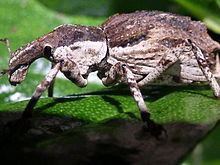Tribe Aterpini Order Beetle | Subfamily Cyclominae Rank Species | |
 | ||
Anagotus stephenensis, commonly known as the ngaio weevil, is a large flightless weevil that is only found on Stephens Island in New Zealand. The ngaio weevil was discovered in 1916 by A.C. O'Connor on Stephens Island. Thomas Broun described it in 1921 as Phaeophanus oconnori after its collector. The weevils were observed at the time to be 'feeding on tall fescue and the leaves of trees'.
The ngaio weevil has a historic range as far away as South Canterbury and was once common, having been found in reasonable numbers (39) in cave deposits produced by the extinct laughing owl. It has a relict population on Stephens Island. Intensive searches in 1971 and 1995 saw one or two specimens indicating it had become rarer than when discovered in 1916, when 15 specimens were collected from Stephens Island.
The weevil is known to live on ngaio trees (Myoporum laetum), feeding on leaves, where it produces a characteristic feeding notch. The adults have also been found on the karaka tree (Corynocarpus laevigatus). The weevil is a large, nocturnal, flightless weevil ranging in length from 20 to 31mm. This species has had its conservation status upgraded to nationally critical. It is protected under Schedule 7 of The 1953 Wildlife Act, making it an offense to collect, possess or harm a specimen.
